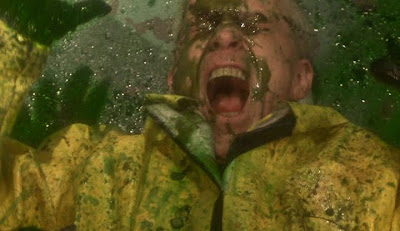Low-Budget
Mould
OK, so just few days ago I was wowed by the poster for Mould* and decided that I’d almost certainly have to watch it. I must admit I wasn’t actually expecting very much: once you’ve seen a number of 21st century B-movies you tend towards pessimism. Most recent films that aim for the schlocky, low-grade style of classic 70s and 80s films do so in such a self-conscious, post-Planet-Terror, we’re-so-very-hip-and-grindhouse way that they’re ultimately pretty disappointing. To my surprise, Mould* resisted all that and played it straight-faced and gorey and, as a result, was a whole lot of fun.
[Yes, the film is actually called ‘Mold’ but the word looks silly without a ‘u’ in the middle. Sorry America. You might be right about ‘color’ but oyu’re wrong about ‘mold’]

The plot is about as complex as you’d expect from a low-budget film about mould. A group of basically good but apparently conscience-free scientists (oh scientists, why are you always evil?) have been funded to create a new form of super-evil life-destroying hyper-contagious mould. Y’know, so America can remain a superpower or something. And kill people. It’s pretty vague, but let’s be honest, who cares? The important point is that this mould is in their lab and it is very, very bad for you.
And it’s demonstration day. So as well as 4 scientists (Old scientist, lady scientist, two young scientists who both fancy the pants off lady scientist) we have a coke-snorting congressman, his effeminate aide, a cigar-toting army general and his dumb, macho soldier aide. So now we have cowards, scientists, bullies and a woman. All locked in together in a building with some mould. AND GUESS WHAT!? Despite all the precautions taken, the mould contaminates one of them and, from that point on, the worry of containment and contamination takes over the film.

Budget-wise, of course, this is very efficient. Most of the action takes place in one room, with a few shots set in the neighbouring corridors. This, thankfully, means they were able to save all the rest of their cash to spend on splattering green goo and blood across… well… everything. Mould is one of those that you can imagine was an awful lot of fun to make and the enthusiasm carries across onto the screen. I don’t want to spoil the surprise(s) but we have splattering heads, exploding internal organs, facial bleeding. And then later, some guns.
There really isn’t very much more to tell: Mould is an awful lot of fun. It does perhaps start a little slowly but the slow-moving first half hour is definitely worth it for the oozing, gooey, mouldy pay-off that follows. This is modern low budget trash made with old-fashioned enthusiasm. Highly recommended.
**Available right now at www.moldthemovie.com **
2LDK - Stop pushing boundaries!

Let’s look at modern films. With a few notable exceptions, cinema seems hellbent on the bizarre (and frankly WRONG) notion that more = better. From Lord of the Rings (MOAR FIGHTING PEOPLE!), to Avatar (MOAR DIMENSIONS!, MOAR MONEY), to Inception (MOAR LAYERS OF REALITY!) there is a definite trend towards the idea of giving you “more bang for your buck”. As cinema prices skyrocket, some bright spark seems to have formulated an idea:
If we throw millions of characters, a mountain of subplots and the biggest special effects ever made at the audience, all spread across roughly 3 hours, then they can’t possibly leave the cinema disappointed and wanting their money back.
Can they?
Well yes. They can. Every time I leave the cinema with a numb rear-end from 3hrs in a seat, having just watched special effects equivalent to the GDP of a small country I feel slightly hollow inside. Modern blockbusters tend to be simply too sprawling, too epic, too mammoth. They need to be cut down to size. Even Inglourious Basterds (my favourite of last year) clocked in at 3hrs or so and would’ve benefitted from being much shorter. Tarrantino had talked about having enough material to make several films; he should’ve done just that, rather than bashing them together into a film which (although wonderful) was simply too much.
So imagine my delight when I stumbled upon this:
The Duel Project was a challenge issued to Ryuhei Kitamura and Yukihiko Tsutsumi by producer Shinya Kawai during a night of drinking. The challenge was for the two directors to see who could make the best feature film with two principal actors/actresses battling in one principal location in the time span of one week.
Quote from wikipedia.
So… hardly any characters, a single location and an incredibly tight schedule? Fantastic. This is the kind of back to basics approach that cinema needs.
To date, I have only seen 2LDK, Tsutsumi’s half of the project. It clocks in at about 70 minutes. It has only two speaking characters. It’s entirely set in one flat (2LDK is a Japanese term to describe a 2 bedroom shared apartment). It’s fast, funny, witty, brutal and violent in equal measures.
The two characters are rival actresses, competing for the same role and discussing their chances. The two very different people begin to needle each other, moving from gentle jibes to cutting remarks and finally escalating to full-on fighting. It’s fantastic. There’s not a single dull moment as the tension is slowly cranked up from a relatively mundane beginning until the outbreak of violence is almost a relief.
I clearly wouldn’t want every film to follow this pattern (though I’m certainly anxious to see the other half of the Duel Project) but it is very refreshing to be shown what can be done with so little. Hollywood terms would have us believe that “low budget” meant only “crappy horror” (no bad thing!) or “over-earnest indie dirge” (which is all too often true!). 2LDK is a timely reminder that there is a lot more to a film than the MOAR IS BETTER fallacy that blockbuster cinema perpetuates.